Neoregelia chlorosticta
Click thumbnails for full size, scaled to a new window.
Neoregelia chlorosticta
(Ed: Brown leaf background glows bright red when wet.)
Identification by Ken Woods as ampulacea Hybrid. October flowering. Different to Neo. Guinea which has green with dark bown spots, rather than brown areas with light spots.
Relabelled as chlorosticta on 04/06 following BSA meeting advice.
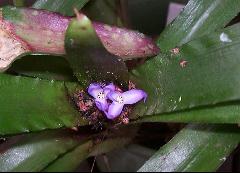
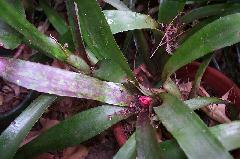
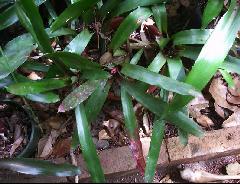
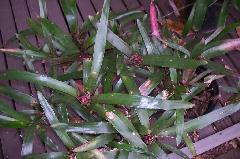
| Ian Hook 11/02 |
Ian Hook 10/02 |
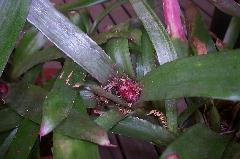
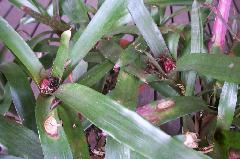
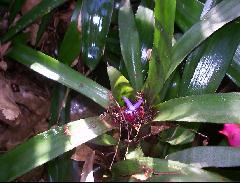
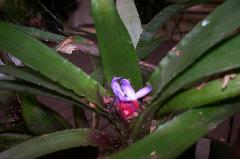
| Ian Hook 10/02 |
Ian Hook 11/02 |
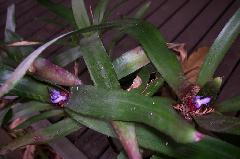
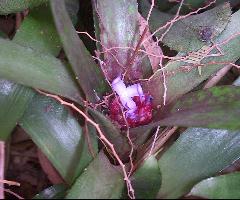
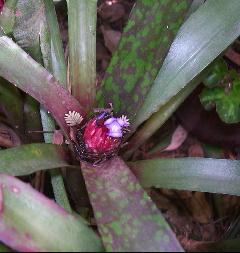
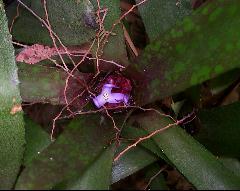
| Ian Hook 11/02 |
Ian Hook 10/03 |
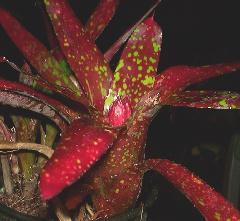
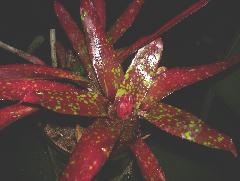
| Ian Hook, more sun, 10/03 |
Ian Hook, more sun, 09/04 |
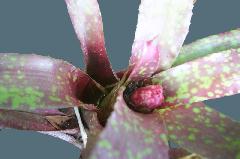
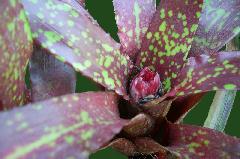
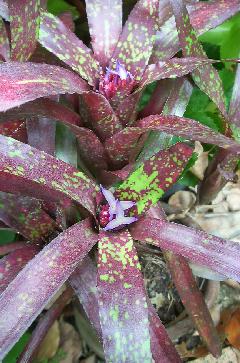
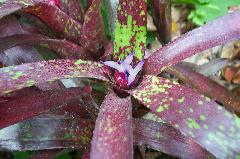
Neoregelia chlorosticta (Baker) L. B. Smith, Phytologia 10: 486. 1964.
Karatas chlorosticta Baker, Handb. Bromel. 7. 1889.
Nidularium chlorosticta E. Morren ex Baker, Handb. Bromel. 7. 1889; nomen.
Billbergia chlorosticta hortus ex Baker, Handb. Bromel. 7. 1889; nomen.
Regelia chlorosticta (Baker) Lindman, Oefvers. Vet. Akad. Forhandl. 47: 543. 1890.
Aregelia chlorosticta (Baker) Mez, DC. Monogr. Phan. 9: 65. 1896.
Neoregelia sarmentosa (Regel) L. B. Smith var chlorosticta (Baker) L. B. Smith, Contr. Gray Herb. 104: 79.1934.
Neoregelia marmorata L. B. Smith, Contr. Gray Herb. 124: 10. 1939; Smithson. Misc. ColI. 126: 157. 1955; in part, as to material cited.
Neoregelia chlorosticta Fritz Encke, Pareys Blumengartnerei 1: 206. 1958; nomen, erroneously attributed to L. B. Smith.
Desc from S&D
Leaves 2-3 dm long, the inner ones vinaceous with large, pale green spots;
Sheaths nearly equaling the blades, ovate or elliptic, sparsely brown-lepidote, forming a more or less utriculate tank;
Blades linear, rounded, apiculate, 25 mm wide, laxly and minutely spinose-serrate, lepidote especially beneath, the outer concolorous.
Inflorescence simple, about equaling the leaf-sheaths, few-flowered, red-purple;
outer bracts ample, shorter than the sepals, hyaline.
Floral bracts spathulate, rounded to retuse, apiculate, much exceeding the pedicels but shorter than the sepals, hyaline;
Pedicels very slender, to 10 mm long.
Sepals 12-18 mm long, connate 2-7 mm, the blades strongly asymmetric, elliptic, obtuse or minutely apiculate;
Petal-blades elliptic, acute, 10-15 mm long, blue-violet;
Stamens exserted above the corolla-throat;
Ovary ellipsoid, constricted at apex.
Type. Morren icon and Kew Hortus s n (holotype, K), cultivated from Brazil.
Distribution. Epiphytic in forest, from near sea level to 1200 m alt, Rio de Janeiro to Parana, Brazil.
BRAZIL. Rio de Janeiro: Itatiaia, Dusen s n (S); 21 Oct 1903, 2196 (S); 1 Jul 1939; Foster 129 (GH); Teresopolis, 22 Aug 1940, Foster 1012 (GH). Sao Paulo: Sao Paulo, 31 Jan 1934, Ostermeyer s n (SP); Ouapiara, 25 Aug 1939, M. Kuhlmann s n (SP, US); Registro, 1962, L. Seidel 271 (HBR). Parana: Caioba, 1 Sep 1939, Foster 449 (GH, US); Paranagua to Curitiba, 11 Nov 1953, Reitz 5818 (HBR, US).
NEOREGELIA CHLOROSTICTA (L. B. Smith) L. B. Smith, comb. nov. Phytologia 10: 486. 1964.
Neoregelia sarmentosa (Regel) L.B. Smith var. chlorosticta L. B. Smith, Contr. Gray Herb. 104: 79. 1934.
Neoregelia marmorata L. B. Smith, Contr. Gray Herb. 124: 10. 1939; Smithsonlan Misc. Coll . 126: 157. 1955. ln part, as to material cited not as to basonym.
Further study shows that Neoregelia chlorosticta has leaves of much thinner texture and more even surface than those of typical N. sarmentosa. Its sepals prove to be very close in form and size to those of collections that I had cited mistakenly under N. marmorata because of the leaf coloration. Actually, N. marmorata has acuminate sepals while the material cited has them rounded and barely apiculate and much smaller.
Protologue
Baker 1889 p.7
18. K. CHLOROSTICTA Baker.
Nidularium chlorostictum E. Morren (M.D).
Billbergia chlorosticta Hort.
Habit of a Billbergia. Leaves 12-20 in a long utricular rosette, lorate, the blade exclusive of the large dilated base 0.5-1 ft. long, an inch broad, firm in texture, reddish brown, with copious green spots, rounded to a cusp at the tip, the marginal prickles minute. Flowers few in a head at the top of the utriculus of leaves. Sepals tinged with red.
Petals protruded 0.5 in. beyond the tip of the calyx.
Hab. Probably Brazil. Described from Prof. Morren's drawing, made in 1884, and a living plant at Kew, which has not yet flowered.
Updated 23/04/24

















